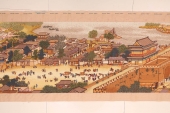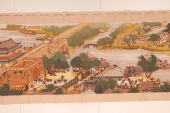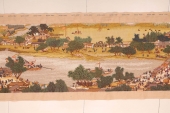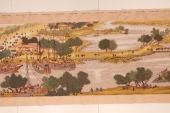清明上河图十字绣
- 编 号:794770
- 销售状态:待售(不可在线交易)
- 库 存: 1
- 售 价:议价
(平台服务时间:周一到周五 9:00-17:00)

- 资质:
- 评分:
1分 2分 3分 4分 5分 6分 7分 8分 9分 10分 7分
- 印象:
- 经营时间:6年
- 展厅面积:300平米
- 地 区:上海-徐汇-其他
| 创作年代 | |||||
|---|---|---|---|---|---|
| 作品分类 | 杂项- 织锦刺绣-近现代刺绣 | 品相 | 全品 | 品种 | 镜心 |
| 种类 | 其它 | 题材 | 其它 | ||
| 作品标签 | |||||
| 适用空间 | |||||
作品介绍
清明上河图,中国十大传世名画之一。为北宋风俗画,北宋画家张择端仅见的存世精品,属国宝级文物,现藏于北京故宫博物院。 清明上河图原画宽70厘米、长652厘米,以长卷形式,生动记录了中国十二世纪北宋都城东京(又称汴京,今河南开封)的城市面貌和当时社会各阶层人民的生活状况,是北宋时期都城汴京当年繁荣的见证,也是北宋城市经济情况的写照。这在中国乃至世界绘画史上都是独一无二的。在六米多长的画卷里,共绘了数量庞大的各色人物,牛、骡、驴等牲畜,车、轿、大小船只,房屋、桥梁、城楼等各有特色,体现了宋代建筑的特征。具有很高的历史价值和艺术价值。《清明上河图》虽然场面热闹,但表现的并非繁荣市景,而是一幅带有忧患意识的“盛世危图”,官兵懒散税务重。 十字绣是一种古老的民族刺绣,具有悠久的历史。由于各国文化的不尽相同,随着时间的推移,十字绣在各国的发展也都形成了各自不同的风格,无论是绣线、面料的颜色还是材质、图案,都别具匠心。 最早的十字绣是在动物皮毛制成的织物上进行刺绣,用的是从蚕茧中抽出来的丝线,这种十字绣在许多国家被用来装饰衣服和家具.由于各国文化不尽相同,随着时间推移,逐渐形成了各自的风格,无论是绣线,面料颜色,还是材质,图案,都各有千秋。黄梅挑花又名“十字挑花”、“十字绣”,起源于唐宋,兴于明清。 《清明上河图》十字绣的色彩众多,人物、牲畜、建筑交错,不同颜色的针线78种,清明上河图最难的一段。这一段描写的是拱廊桥附近人头涌动的热闹景象。里面有300多个人,形态不一。屋、桥梁、城楼等各有特色,体现了宋代建筑的特征,具有很高的收藏价值和艺术价值。全幅场面浩大,内容极为丰富,表现细腻、色泽丰富、质感强烈。男女老少都有,农民商人也都不缺,每个人物都可以在动作或者服饰方面将自己的身份表现出来,相互之间没有雷同。人们的衣服纹路较简单,依照身份地位的不同使用不同的色彩,有颜色鲜艳的地方也有颜色暗淡的地方,相辅相成使得整幅画卷的整体色调相互和谐。 由于下针太过复杂,每天只能绣手机那么大的面积。十字绣制起来工作量技艺要求非常高,绣错一针都不行,有时候发现图案不对,就得拆了重新绣。十字绣作为中国的一项传统手工工艺,《清明上河图》以其内容的浩大,在十字绣图案设计中占有重要地位。繁杂的图案设计和浩大的工程给清明上河图十字绣的制作增加了难度,此幅十字绣做工非常精细,色彩线条分明,人物细致生动,整体十字绣看起来活灵活现人物包罗万象、景物鳞次栉比,颜色丰富、深浅融汇。为使作品更加完美,藏家还将房舍、轿子、舟船用黑色丝线勾边,使得画面呈现出立体感。 此幅作品以现代十字绣展现出汴河码头繁华热闹的景象,长卷如画般优美,色泽明艳亮丽,平整光洁,质感强烈,纯手工绣成,绣工精细。从远处看如同用笔绘成,大气磅礴,凑近看,一针一线毫不含糊,拉线均匀连贯,方向一致,针脚紧密,亭台、楼宇、人物、牲畜绣得精细而生动,令人叹为观止。 此幅十字绣耗时5年之久,佳作难得。生活中,坚持做一件事并持之以恒是非常困难的,想要沉淀下来做一件事,总是有各种各样的理由让我们坚持不下去,往往越是关注需要坚持的目标,心里压力就比较大,当因为各种理由没有坚持下去,内心的焦虑总是让人感到烦躁,那么怎样才能将自己设定的目标坚持下去? 《清明上河图》以其内容的浩大,在十字绣图案设计中占有重要地位,繁杂的图案设计和浩大的工程给清明上河图十字绣的制作增加了难度,具有很高的历史价值和艺术价值。然而想拥有一幅《清明上河图》真品是不可能的,因而大家都喜欢用十字绣来替代。清明上河图十字绣也是成了当之无愧的“国粹”极具收藏价值。 The riverside painting of Qingming Dynasty is one of the ten famous paintings handed down in China. It is a custom painting of the Northern Song Dynasty. It is the only surviving masterpiece of Zhang Zeduan, a painter of the Northern Song Dynasty. It belongs to the national treasure level cultural relics and is now stored in the Palace Museum of Beijing. The original picture of Shanghe River in the Qing Dynasty, 70 cm wide and 652 cm long, vividly records the city appearance of Tokyo (also known as Bianjing, now Kaifeng, Henan Province), the capital city of the Northern Song Dynasty in the 12th century, and the living conditions of people of all walks of life at that time. It is the witness of the prosperity of Bianjing, the capital city of the Northern Song Dynasty, and also the portrayal of the urban economic situation of the Northern Song Dynasty. This is unique in the history of Chinese and even world painting. In the six meter long picture, a large number of people of all colors, cattle, mules, donkeys and other livestock, cars, sedans, large and small ships, houses, bridges, city buildings and so on, are painted, reflecting the characteristics of the Song Dynasty architecture. It has high historical value and artistic value. Although the scene of the picture of going to the river during the Qingming Festival is lively, what it shows is not a prosperous city scene, but a "prosperous and dangerous picture" with a sense of suffering. The officers and soldiers are lazy and heavy in taxation. Cross stitch is an ancient national embroidery with a long history. Due to the different cultures of different countries, cross stitch has formed different styles in the development of different countries with the passage of time. No matter the color, material and pattern of embroidery thread and fabric, they have their own ingenuity. The earliest cross stitch was embroidered on the fabric made of animal fur, using the silk thread drawn from the cocoon. This kind of cross stitch was used to decorate clothes and furniture in many countries. Due to the different cultures of different countries, with the passage of time, it gradually formed their own style, no matter the embroidery thread, fabric color, material, pattern, all have their own advantages. Huangmei Tiaohua, also known as "cross Tiaohua" and "cross embroidery", originated in Tang and Song Dynasties and flourished in Ming and Qing Dynasties. There are many colors of cross stitch in the riverside map of Qingming Dynasty. People, livestock and buildings are interlaced. There are 78 kinds of stitches of different colors. It is the most difficult section of riverside map of Qingming Dynasty. This passage describes the bustling scene of people around the arcade bridge. There are more than 300 people in it, in different forms. Houses, bridges, city buildings and so on have their own characteristics, reflecting the characteristics of Song Dynasty architecture, with high collection value and artistic value. The whole scene is vast, rich in content, delicate in performance, rich in color and strong in texture. There are men, women, old and young, and there is no shortage of farmers and businessmen. Each character can show his or her identity in action or clothing, and there is no similarity between them. People's clothing lines are simple, according to the different status of the use of different colors, there are bright colors and dark colors, which complement each other to make the overall color harmony of the whole picture. Because the stitching is too complicated, you can only embroider the large area of the mobile phone every day. Cross stitch requires a lot of work and skills. It's not good to embroider a wrong stitch. Sometimes, if you find that the pattern is wrong, you have to remove it and re embroider it. As a traditional handicraft in China, cross stitch is very important in the design of cross stitch pattern because of its vast content. The complicated pattern design and large-scale project increased the difficulty for the production of the cross stitch on the riverside in the Qingming Dynasty. This cross stitch is very fine in workmanship, with clear color lines and detailed and vivid figures. The whole cross stitch looks like a vivid cross stitch with a wide range of figures, scenes, rich colors, deep and shallow fusion. In order to make the work more perfect, the collectors also use black silk thread to hook the edges of houses, sedan chairs and boats, making the picture appear three-dimensional. This work shows the bustling scene of Bianhe wharf with modern cross stitch. It is beautiful as a picture, bright and bright in color, smooth and smooth, strong in texture, pure hand embroidered and fine in workmanship. From a distance, it's like painting with a pen. It's majestic. From a close view, the stitches are unambiguous, the stay wires are even and coherent, the directions are consistent, the stitches are tight, and the pavilions, buildings, people and livestock are embroidered with exquisite and vivid embroidery, which is amazing. This cross stitch took five years, and it's a rare masterpiece. In life, it's very difficult to stick to one thing and stick to it. If we want to settle down and do one thing, there are always various reasons why we can't stick to it. The more we pay attention to the goal we need to stick to, the more pressure we have on our hearts. When we don't stick to it for various reasons, the anxiety in our hearts is always annoying, so how can we set our own goals Keep going? Qingming shanghetu, with its vast content, plays an important role in cross stitch pattern design. Complicated pattern design and vast projects add difficulty to the production of Qingming shanghetu cross stitch, which has high historical and artistic value. However, it is impossible to have a real picture of the river during the Qingming Festival, so we all like to use cross stitch instead. The cross stitch on the riverside in the Qing and Ming Dynasties has also become a well deserved "quintessence of the country" with great collection value.

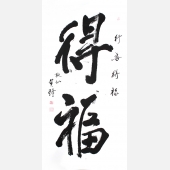 黄琦
黄琦 贾平西
贾平西 测试用艺术
测试用艺术 胡江
胡江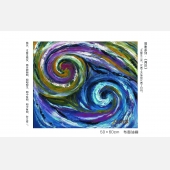 庞明璇
庞明璇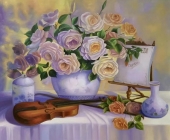 未知
未知 张大千
张大千 郑霞娟
郑霞娟


